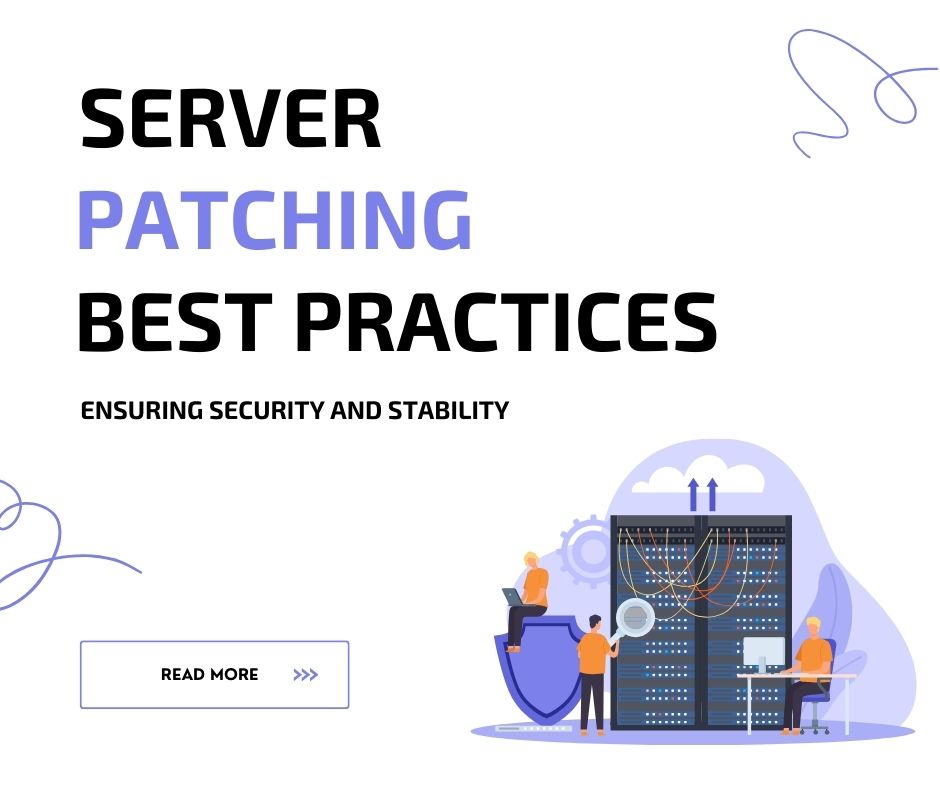Server Patching Best Practices: Ensuring Security and Stability
Written by
Shivam Mahajan on the 16th Nov 2023
Server security continues to be a key concern for individuals and businesses in the constantly shifting technological world. This concern leads to server patching for enterprises and individuals. In a nutshell, patching is an essential component of maintaining a secure server environment. Server patching includes updating, fixing, and improving server softwares to address vulnerabilities and improve performance.
So, if you’re worried about server security and want to learn the best practices to safeguard it, you’ve landed in the right place. In this post, we will look at the server patching best practices so that you can create a secure server environment. Let’s get started.
Server Patching: A Quick Overview
Patching a server is the process of upgrading and safeguarding its software by applying patches, which are changes to the current code. These patches are frequently used to fix bugs, and problems, or to enhance overall system performance. Patching is essential for protecting servers from possible security risks because it closes flaws that hostile actors may exploit. Server patching is required regularly to guarantee the stability, security, and resilience of a server infrastructure.
To reduce the possibility of interruptions, patches are tested in a controlled environment before being sent to production servers. Efficient server patching is a crucial practice in both company and individual settings for preserving the health and integrity of servers.
Server Patching Best Practices
Maintaining a comprehensive Inventory
Keeping an accurate list of all the devices in your network, together with their patch status and priority, is essential to effective patch management. This detailed data serves as a road map, offering a clear path for prioritising essential systems that require rapid care. The accuracy of this inventory is critical because it allows for a systematic approach to patch deployment based on the unique demands of each device.
A well-maintained inventory not only streamlines the patch management process, but it also improves its efficacy by ensuring that critical systems are recognised and serviced as soon as possible. In essence, this complete device inventory acts as a guiding tool, allowing for more focused and organised patch application and contributing to the overall effectiveness of your patch management strategy.
Thoroughly Test Patches
Establishing a testing environment that precisely imitates your live configuration is critical before sending out fixes in a production system. This enables an in-depth investigation of how patches affect your setups and applications. The testing process is critical in ensuring that patch implementation does not interrupt functionality or bring unexpected difficulties. This pre-deployment testing setting functions as a precaution by simulating the real-world conditions of your system, offering insights into potential issues before fixes are delivered to production servers.
In simple terms, testing is a preventative step that ensures updates are seamlessly integrated into your operating environment while minimising the possibility of disruptions or unwanted consequences. This methodical testing technique helps to a more dependable and stable production environment.
Patch Scheduling and Frequency
Successful server administration must establish regular maintenance windows and patching frequencies. Patching at certain periods might help to minimise disruptions to corporate operations and ensure a seamless workflow. It must be done to strike a balance between the need for rapid patching and the possible impact on users. This planned method enables you to deploy patches at appropriate times, decreasing the possibility of interfering with vital work.
Furthermore, having established maintenance windows simplifies communication with stakeholders, allowing them to organise their operations around these times. This proactive scheduling improves the security, and performance of your servers, demonstrates a thoughtful consideration for your organisation’s operational needs, and fosters a harmonious balance between maintaining a secure infrastructure and sustaining uninterrupted business operations.
Implement Change Management Processes
To maintain openness and accountability, it is good to thoroughly record the patching process, including all necessary permissions and identifying stakeholders for notification. This detailed documentation helps in keeping a clear record of actions made during the patching phase. The use of change management methods becomes critical in ensuring that patches are deployed in a systematic and controlled way. These processes contribute to an organised approach by specifying approval workflows and communication routes, reducing confusion, and assuring adherence to a well-defined routine.
Change Management Process protects against any oversights in the patch deployment process. In short, extensive documentation combined with good change management procedures provides the foundation of a methodical and accountable approach to server patching.
Streamline and Automate the Patching Process
Tools like Attune play an important part in automating the patching process. It allows for the precise and efficient replication of manual typing through the meticulous orchestration of scripts, commands, and processes.
Patch Automation tools help reduce the risk of human mistakes and ensure uniform and error-free patch deployment across systems. These tools accelerate patch deployment by automating repetitive activities, improving the overall efficiency of the patch management lifecycle.
Using automation tools such as Attune simplifies patch distribution and strengthens system integrity by eliminating the possibility of manual errors in the complex process of patch management.
Backup and Rollback Plans
Creating strong backup and rollback procedures is a key safety step in server administration. Before beginning patch applications, complete backups of key data and configurations must be performed. This precautionary measure guarantees that, in the case of unanticipated patching concerns, a quick and safe fallback to a stable state is available.
Strong backup solutions provide safety against potential interruptions or data loss, providing a dependable way to restore systems to their pre-patch state. Organisations strengthen their capacity to respond effectively to any unanticipated obstacles throughout the patching process by constantly adapting and validating these backup and rollback procedures, hence increasing the overall resilience of their server infrastructure.
Continuous Improvement
Every patching cycle provides an excellent chance for growth and development. Evaluate the process’s effectiveness, gather feedback, and identify areas for improvement. You can optimise operating efficiency and adapt to new security risks by continuously evaluating and improving your patch management approach.
Using a feedback loop guarantees that each cycle’s lessons contribute to an ongoing enhancement process. Monitoring the success of your patching methods frequently allows for the detection of flaws and the installation of proactive solutions. This dedication to improvement not only strengthens the durability of your server infrastructure but also develops a dynamic and adaptable approach to cybersecurity, enabling your organisation to successfully tackle emerging threats and problems in an ever-changing technological world.
Conclusion
The effectiveness of server patching is critical to ensuring a safe and dependable IT infrastructure. Following these server patching best practices will allow you to optimise the patching process while reducing potential risks and strengthening your organisation’s overall security posture. It’s necessary to understand that a precisely designed and implemented patch management strategy does more than just protect your IT environment from vulnerabilities; it actively adds to the stability and efficiency of your IT system.
Adopting effective server patching as a key practice links your organisation with the developing cybersecurity landscape, fosters resilience, and ensures that your IT infrastructure stays strong and dependable in the face of increasing threats and problems.
Post Written by Shivam Mahajan
Shivam Mahajan is an editor skilled in SysOps, Tech, and Cloud. With experience at AttuneOps and other companies, he simplifies complex technical material for easy understanding.



Comments